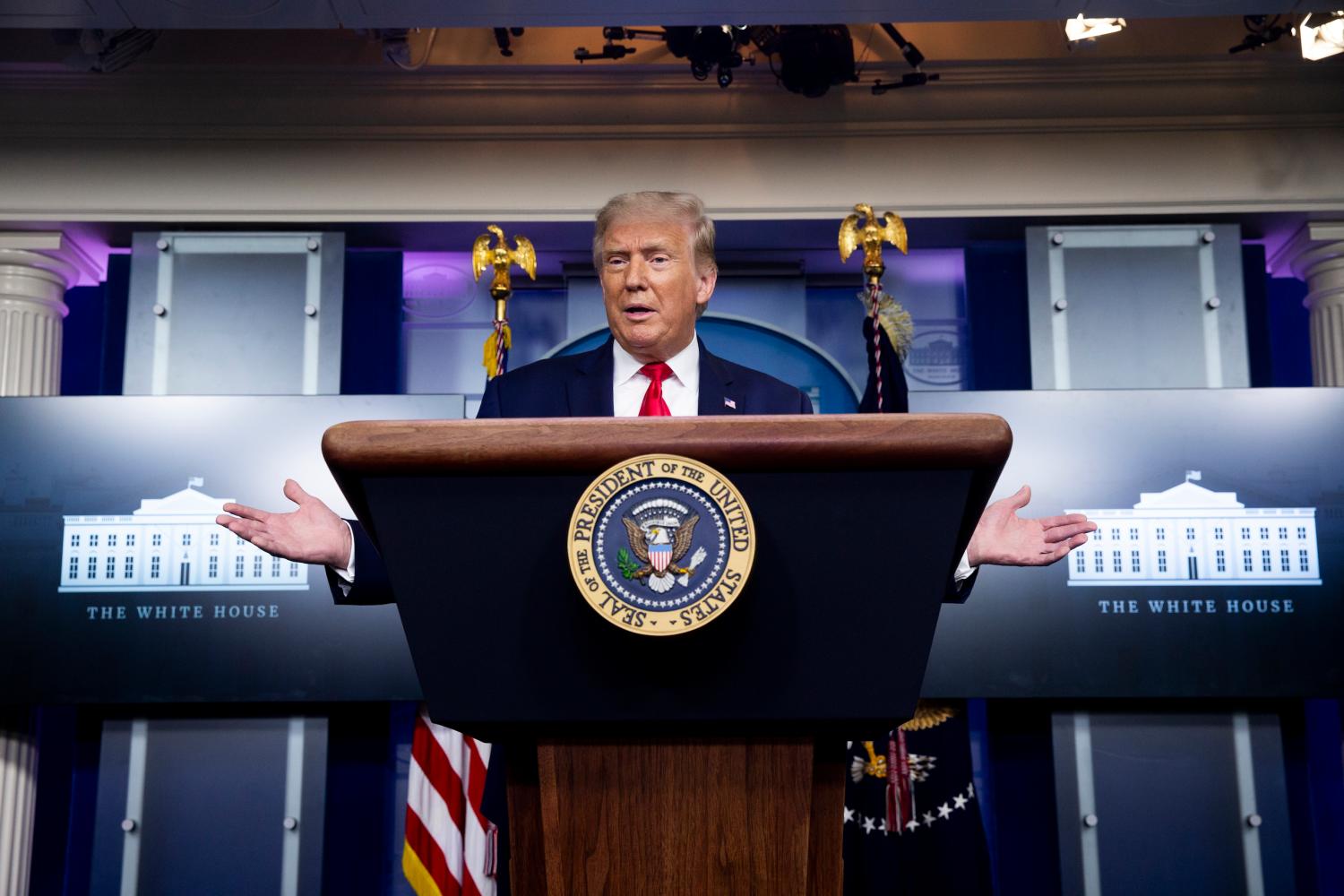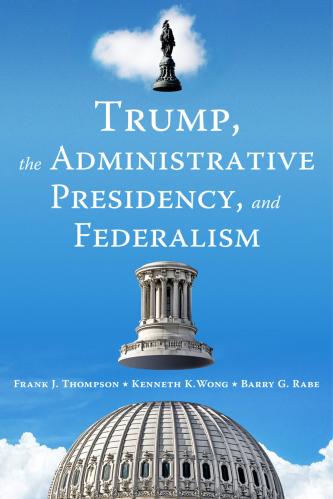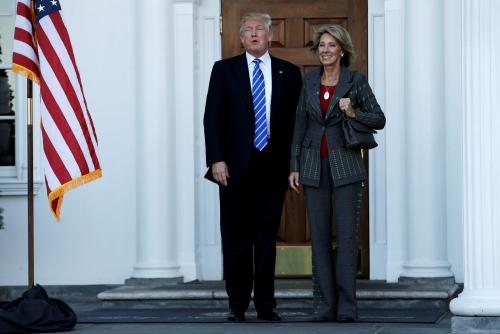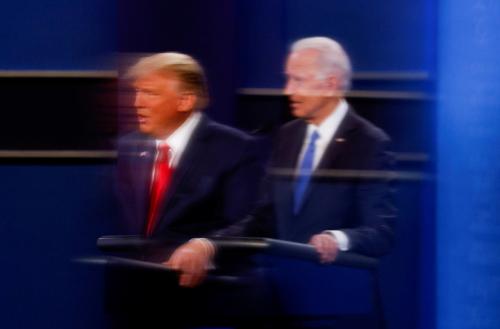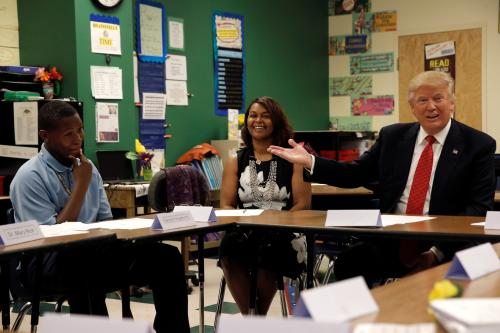According to a Gallup poll conducted in September, 82% of registered voters rate education as “extremely important” or “very important” in deciding how to vote in the U.S. presidential election. The economy (89%) and terrorism and national security (83%) were the only issues that more voters saw as extremely or very important.
Identifying education as a top presidential issue may seem surprising because education is primarily a state and local responsibility, and because the federal government has provided only about one out of every 10 dollars in school spending. Yet, since the 1960s, U.S. presidents have used their executive, administrative, and political power to pursue policy goals that galvanized the nation’s attention to issues of equity and accountability in our public schools. Ronald Reagan appointed a national commission that crafted the seminal report, “A Nation at Risk,” that connected student performance to global competitiveness. Barack Obama used Race to the Top grants and federal waivers to engage states to adopt systemic initiatives, such as the Common Core learning standards and direct intervention strategies to turn around low-performing schools.
Trump’s use of administrative power
Like his predecessors, President Donald Trump had the opportunity to use his executive, administrative, and political power to shape education policy. As Frank J. Thompson, Barry G. Rabe, and I document in our new book published by the Brookings Institution Press—“Trump, the Administrative Presidency, and Federalism”—Trump’s education policy agenda aimed at weakening federal oversight and reversing Obama’s commitment on civil and student rights in public schools.
To be sure, Trump’s presidency did not pursue major legislation in public education. Trump’s lack of legislative accomplishments in education policy can be attributed in part to Congress’s enactment of the 2015 Every Student Succeeds Act (ESSA), the latest in a series of reauthorizations of the Elementary and Secondary Education Act (ESEA) originally passed in 1965. ESSA granted states flexibility when it came to accountability and placed restrictions on federal interference in state education decision-making or set common standards across states. There was little expectation when Trump took the presidential oath in January 2017 that Congress had an interest in revisiting or reopening these issues addressed in the bipartisan ESSA adopted in December 2015. Further, the administration enjoyed mixed success in gaining congressional approval for budgetary requests in education including proposals to repurpose categorical funding for school choice and to downsize the U.S. Department of Education.
One can also view Trump’s unilateral approach as a continuation of recent patterns where presidents turn on a regular basis to executive and administrative tools to reverse the policies of a prior administration. Using unilateral actions, President Trump significantly weakened federal oversight to reverse a growingly assertive federal role that was supported by the Obama administration. Trump administration officials unilaterally launched actions aimed at weakening enforcement of student rights and civil rights in public schools.
On civil rights oversight and enforcement, the Trump administration shifted the focus away from systemic conditions in public schools. For example, the Education Department’s Office for Civil Rights (OCR) closed a total of 17,797 cases in 2017 and another 14,074 cases in 2018. In contrast, the Obama administration closed 8,637 cases during its last year in office. These differences between the Trump and the Obama years were closely related to the policy shift from focusing on systemic conditions to individual complaints. The OCR also revised the guidebook on investigation by removing the procedures to be used in establishing systemic bias. Consequently, the pace of case closures and dismissals was much faster than that of previous administrations, particularly Obama’s administration, which had required signoffs from D.C. headquarters for all case closures.
The Trump administration’s reversal on civil rights enforcement directly affected issues pertaining to racial/ethnic discrimination in school disciplinary actions. The Obama administration issued guidelines putting schools on notice that they could be violating federal law if racial disparities in student discipline and punishment existed in their schools. After Trump assumed the presidency, the Department of Justice and the Department of Education jointly issued a Dear Colleague Letter notifying schools of their withdrawal of the policy guidance that the Obama administration had issued on nondiscriminatory school discipline in 2014. The Trump administration justified its action on grounds that “states and local school districts play the primary role in establishing educational policy.” The decision triggered sharp opposition from Democratic lawmakers and civil rights organizations. House Education and Labor Committee Chair Robert Scott (D-Va.) asserted that “rescinding the guidance will stall, if not reverse our progress toward addressing these disparities.”
Meanwhile, the Trump administration continued undercutting the rights of transgender students by turning its attention to athletics. The Department of Education launched an investigation concerning the rights of transgender athletes to compete with peers in their self-defined gender group. In response to a lawsuit on behalf of student athletes and their parents in Connecticut, which claimed the full participation of transgender athletes had resulted in unfair sports competition, the Office for Civil Rights in the Department of Education formally launched an investigation into Connecticut’s policy on transgender athletes in August 2019.
Consistent with its efforts to broaden the supply of schooling services from non-governmental sources, the Trump administration supported the entry of providers associated with religious institutions. On March 11, 2019, Education Secretary Betsy DeVos wrote House Speaker Nancy Pelosi (D-Calif.) stating that the Education Department found portions of sections of the ESEA unconstitutional, referencing the U.S. Supreme Court’s decision in Trinity Lutheran Church of Columbia, Inc c. Comer, 137 S. Ct. 2012 (2017), and stating that the Education Department aimed to “refrain from enforcing, applying, or administering” these provisions. The department’s decision signaled how the Trump administration expansively interpreted the court decision in favor of its policy position and used administrative tools to further its policy goal of diversifying providers of educational services.
Erosion or restoration of federal oversight?
It remains to be seen whether Trump’s administrative presidency has substantially modified the federal role in K-12 education, though it clearly has scored some victories. The Trump administration accelerated the devolution of major decisions from the federal level to the states, a trend already kindled by ESSA. It backtracked from federal enforcement of provisions designed to bolster the rights of minorities, transgender students, and people with disabilities. Of particular note, it significantly reduced civil rights enforcement. It also pushed the envelope in championing school choice, particularly in seeking to make federal aid available to religiously affiliated schools.
Without much federal oversight or intervention, variation in the practices of state education departments and local school districts may well grow over time. For instance, 17 states allowed transgender athletes to compete in high school sports based on their declared gender identity, while seven states placed restrictions that made it difficult for transgender athletes to compete in high school sports.
In just a few days, American voters will have the opportunity to decide whether to endorse or reverse Trump’s education policy agenda. Voters’ decisions will have policy consequences. In January 2021, will America see an administrative presidency that further weakens federal oversight in student and civil rights? Or will America welcome an administrative presidency that restores federal leadership in schooling opportunity for all? The stakes for public school students are high.

